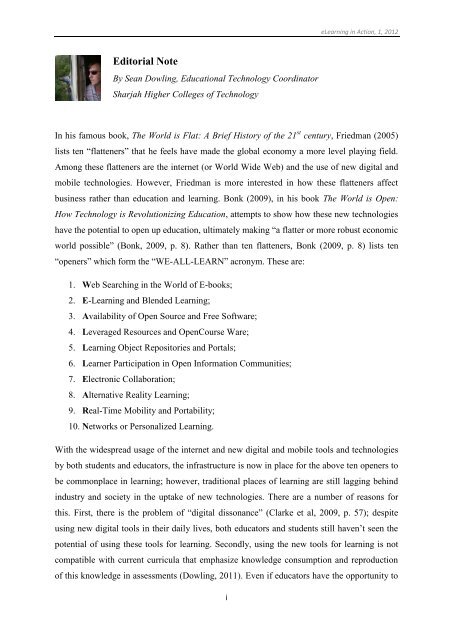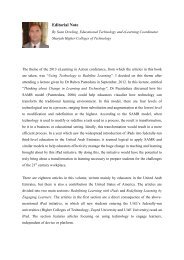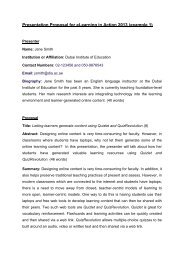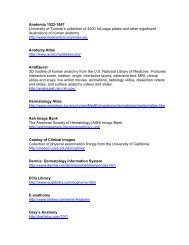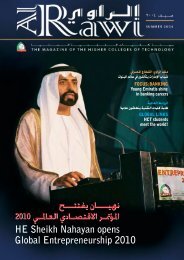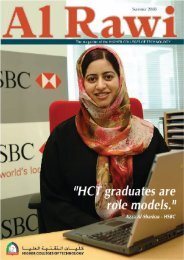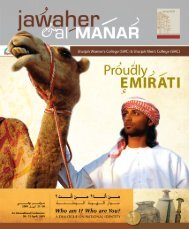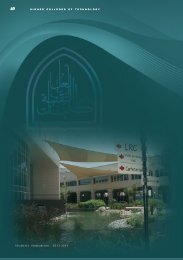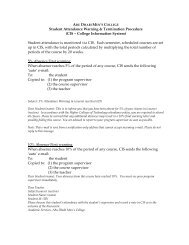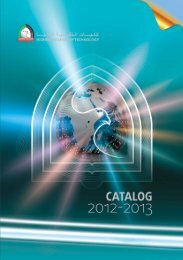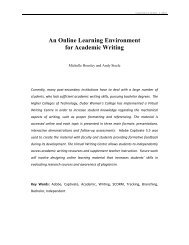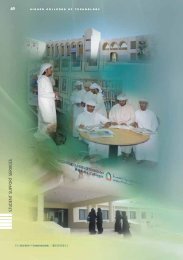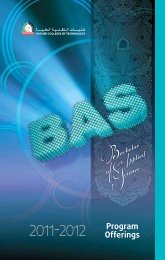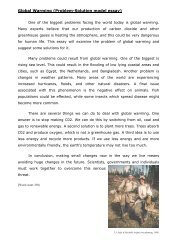Editorial Note - Sharjah Women's College - Higher Colleges of ...
Editorial Note - Sharjah Women's College - Higher Colleges of ...
Editorial Note - Sharjah Women's College - Higher Colleges of ...
Create successful ePaper yourself
Turn your PDF publications into a flip-book with our unique Google optimized e-Paper software.
eLearning in Action, 1, 2012<br />
<strong>Editorial</strong> <strong>Note</strong><br />
By Sean Dowling, Educational Technology Coordinator<br />
<strong>Sharjah</strong> <strong>Higher</strong> <strong>College</strong>s <strong>of</strong> Technology<br />
In his famous book, The World is Flat: A Brief History <strong>of</strong> the 21 st century, Friedman (2005)<br />
lists ten “flatteners” that he feels have made the global economy a more level playing field.<br />
Among these flatteners are the internet (or World Wide Web) and the use <strong>of</strong> new digital and<br />
mobile technologies. However, Friedman is more interested in how these flatteners affect<br />
business rather than education and learning. Bonk (2009), in his book The World is Open:<br />
How Technology is Revolutionizing Education, attempts to show how these new technologies<br />
have the potential to open up education, ultimately making “a flatter or more robust economic<br />
world possible” (Bonk, 2009, p. 8). Rather than ten flatteners, Bonk (2009, p. 8) lists ten<br />
“openers” which form the “WE-ALL-LEARN” acronym. These are:<br />
1. Web Searching in the World <strong>of</strong> E-books;<br />
2. E-Learning and Blended Learning;<br />
3. Availability <strong>of</strong> Open Source and Free S<strong>of</strong>tware;<br />
4. Leveraged Resources and OpenCourse Ware;<br />
5. Learning Object Repositories and Portals;<br />
6. Learner Participation in Open Information Communities;<br />
7. Electronic Collaboration;<br />
8. Alternative Reality Learning;<br />
9. Real-Time Mobility and Portability;<br />
10. Networks or Personalized Learning.<br />
With the widespread usage <strong>of</strong> the internet and new digital and mobile tools and technologies<br />
by both students and educators, the infrastructure is now in place for the above ten openers to<br />
be commonplace in learning; however, traditional places <strong>of</strong> learning are still lagging behind<br />
industry and society in the uptake <strong>of</strong> new technologies. There are a number <strong>of</strong> reasons for<br />
this. First, there is the problem <strong>of</strong> “digital dissonance” (Clarke et al, 2009, p. 57); despite<br />
using new digital tools in their daily lives, both educators and students still haven’t seen the<br />
potential <strong>of</strong> using these tools for learning. Secondly, using the new tools for learning is not<br />
compatible with current curricula that emphasize knowledge consumption and reproduction<br />
<strong>of</strong> this knowledge in assessments (Dowling, 2011). Even if educators have the opportunity to<br />
i
eLearning in Action, 1, 2012<br />
use new digital tools for learning, as the learning focuses not just on the product but also the<br />
process, assessment presents more challenges (Ehlers, 2009; Gray et al, 2010). But the above<br />
problems are not intractable and this volume aims to show how educators are using new<br />
digital tools and technologies with their students to open up learning, thereby preparing the<br />
new generation for the knowledge-based society in which they will live and work.<br />
There are eighteen articles in this volume, written mainly by educators in the United Arab<br />
Emirates, but there are also contributions from Finland and the United States <strong>of</strong> America. The<br />
articles are divided into five main sections: Mobile and Web-based Applications, Online<br />
Learning Environments, ePortfolios, Blended Learning and Other eLearning Activities.<br />
Section One: Mobile and Web-based Applications<br />
In the opening article, Games for English, English for Games, David Patent discusses two<br />
web-based game interventions that were employed in a Foundations English program at the<br />
<strong>Higher</strong> <strong>College</strong>s <strong>of</strong> Technology (HCT), Ras Al Khaimah Men’s <strong>College</strong>, in the United Arab<br />
Emirates. Web-based and digital games are becoming very popular in the Arab region among<br />
young people. Despite some skepticism regarding the positive value <strong>of</strong> digital games, they<br />
have been shown to motivate learners and may help develop language skills. The games were<br />
used to supplement and expand upon topics the learners were studying in their textbook, and,<br />
according to David, the learners seemed to respond positively to the interventions.<br />
In his article, Online-Auctions, Storefront: Emirati Women Unleash Creative Talent, Dr<br />
Alfred Millar describes a technology-based class project in e-commerce that was introduced<br />
in the Business Faculty at HCT, Fujairah Women’s <strong>College</strong>. In this project, a range <strong>of</strong> webbased<br />
and digital technologies was used for e-Business students to construct storefront and<br />
online-auction websites. Dr Millar believes that this entrepreneurial start-up unleashed<br />
exceptional creative ability and marketing talent in the participating students, thereby giving<br />
them skills that could not be achieved with traditional classroom learning.<br />
In Teambox: An Online Project Management Collaborative Tool for Student Group Projects,<br />
Tamilselvan Mahalingam explores how an online project management collaboration website<br />
enhances the co-construction <strong>of</strong> knowledge and the performance <strong>of</strong> the students’ group<br />
projects in higher educational contexts. It also addresses how well an online collaborative<br />
ii
eLearning in Action, 1, 2012<br />
web application called Teambox can facilitate the group learning activities. Tamilselvan also<br />
showcases a collaborative project by business students at HCT, Dubai <strong>Women's</strong> <strong>College</strong>.<br />
Darrin Jones, in Using Screencasts for Tutorials and Student Presentations, discusses the<br />
benefits <strong>of</strong> screencasts created with web-based applications and their uses in classrooms. The<br />
article primarily focuses on how screencasts have been used in an English preparatory<br />
program at HCT, Fujairah Women’s <strong>College</strong>, but there is also a discussion <strong>of</strong> how<br />
screencasts could be used in other disciplines. Darrin suggests using screencasts in two ways:<br />
to make tutorials that explain technological and learning skills being covered and to<br />
encourage students to create their own screencasts for projects and presentations.<br />
In their chapter, Developing Mobile Applications for the Classroom: Embracing new<br />
Technologies, Ali Farhat and Dr John Raven outline how mobile devices and applications are<br />
emerging technologies that have begun to impact educational practices across many learning<br />
contexts. They caution that, like all technologies, mobile devices and applications need to be<br />
chosen carefully to suit the target educational setting. The article then presents a set <strong>of</strong> mobile<br />
applications that were specifically written by IT Faculty to suit Foundations-level students at<br />
HCT, <strong>Sharjah</strong> Men’s and Women’s <strong>College</strong>s. Student feedback concerning their effectiveness<br />
is also shared.<br />
In the final article <strong>of</strong> this section, Convert Your Thinking! Creativity and Imagination using<br />
Mobile Applications, Dr Ferial Khaddage from HCT, <strong>Sharjah</strong> Women’s <strong>College</strong>, and Pr<strong>of</strong><br />
Gerald Knezek, University <strong>of</strong> North Texas, discuss how the current rapid digital evolution is<br />
changing the way students learn and perform tasks. They state that mobile technologies are<br />
shifting our paradigms and that teachers need to learn how to meet the challenges <strong>of</strong> the<br />
knowledge society to cater for the digital learner. The article explores mobile applications<br />
that can enhance student creativity and imagination and introduces some classroom-based<br />
research that can be carried out via this technology. Two apps, Autodesk Sketchbook Mobile<br />
and Bump, are introduced as examples for a creative learning environment.<br />
Section Two: Online Learning Environments<br />
Dr Damodharan Varadarajan, in Using Wimba Classroom as an Effective Online Learning<br />
Tool, discusses the issue <strong>of</strong> keeping students engaged in Wimba Classroom with the purpose<br />
<strong>of</strong> creating a favorable learning experience for his students at HCT, Dubai Women’s <strong>College</strong>.<br />
iii
eLearning in Action, 1, 2012<br />
Wimba Classroom is a virtual on-line presentation environment that includes audio, video,<br />
chat and application sharing. It can be used for synchronous or asynchronous virtual<br />
classroom, and can be integrated into Blackboard and other content/learning management<br />
systems. Dr Damodharan describes the features <strong>of</strong> Wimba Classroom and also the steps<br />
involved in making it an effective on-line learning tool.<br />
In their article, An analysis <strong>of</strong> Two Online Mathematics Course Delivery Programs, Jon<br />
Orthmann, Jeanann El-Jadiry, Jeya Kumar, Reem Arafat and Nancy Fahnestock discuss the<br />
trial <strong>of</strong> two different interactive mathematics s<strong>of</strong>tware programs with native Arabic-speaking<br />
students in the context <strong>of</strong> foundations-level mathematics courses at HCT, Al Ain Women’s<br />
<strong>College</strong>. They describe the different products, report on student feedback, summarize and<br />
compare and contrast the results from assessments. In addition, they discuss time spent on the<br />
program, analyze questionnaires given to students at the end <strong>of</strong> the study and compare the<br />
advantages and disadvantages <strong>of</strong> both online programs from the teacher perspective.<br />
In Learner-centered Do-it-yourself Learning Management Systems, Vance Stevens, from the<br />
HCT CERT Program in Abu Dhabi, addresses situations where teachers are expected to<br />
develop viable courses quickly as well as make use <strong>of</strong> available technological resources,<br />
<strong>of</strong>ten on minimal budgets. He describes how flexibility and creativity are achieved with<br />
DIYLMS (do-it-yourself LMS) using a mashup <strong>of</strong> Web 2.0 tools such as a wiki portal for<br />
course information and links, Google Docs for student writing and feedback, Google<br />
Hangout for live sessions, Skype group chat for synchronous and asynchronous<br />
communication, and blogging as a means for students to showcase their work and enter into<br />
conversations about it.<br />
In his paper, Open Learning Management Systems: A Case Study, Sean Dowling describes<br />
how courses delivered using traditional learning management systems such as Blackboard are<br />
barriers to open learning. He states that these online courses are time-bound, accessible only<br />
during a specific semester, walled <strong>of</strong>f from other courses and teacher centric. The article<br />
discusses how WordPress blogs have been used with Sean’s students at HCT, <strong>Sharjah</strong> Men’s<br />
<strong>College</strong> to create an open learning management system that can be accessed by<br />
anyone/anytime/anywhere and that can give students more opportunities to participate in their<br />
own learning.<br />
iv
eLearning in Action, 1, 2012<br />
Nicole Shammas and Jumana Tarazi, in Dubai – Japan Virtual International Exchange,<br />
discuss a virtual international exchange between students in HCT, Dubai Women’s <strong>College</strong><br />
and Osaka, Japan. The article focuses on the way technology has been used to link English<br />
language students in the two countries in order to increase the students’ cultural awareness, to<br />
improve their English language and IT skills, to explore innovative ways in teaching and<br />
learning, and to provide an authentic learning experience.<br />
In their article, An Online Learning Environment for Academic Writing, Michelle Housley<br />
and Andy Steele describe the current situation where many post-secondary institutions have<br />
to deal with a large number <strong>of</strong> students, who lack sufficient academic writing skills, pursuing<br />
bachelor degrees. The article discusses how HCT’s Dubai Women’s <strong>College</strong> has<br />
implemented a Virtual Writing Centre in order to increase student knowledge regarding the<br />
mechanical aspects <strong>of</strong> writing, such as proper formatting and referencing. Michelle and Andy<br />
also discuss how the current learning material has been created and outline future work that<br />
will involve designing online learning material that increases students’ skills in evaluating<br />
research sources and awareness <strong>of</strong> plagiarism.<br />
Section Three: ePortfolios<br />
In Tools for Dynamic Portfolios, Diane Evans and Christine Lampe, from HCT, Al Ain<br />
Women’s <strong>College</strong>, investigate dynamic portfolio processes. They provide key points <strong>of</strong><br />
underpinning theory and <strong>of</strong>fer a definition. They also provide three examples demonstrating<br />
the use <strong>of</strong> tools which support dynamic portfolios in different contexts: Office Administration<br />
students use Adobe Acrobat Pro 9 s<strong>of</strong>tware to develop a repository <strong>of</strong> evidence <strong>of</strong> work<br />
completed; Health Administration students use PBworks to upload and share learning<br />
activities during a course; and Foundations English students use WordPress blogs to develop<br />
writing portfolios.<br />
Paul Leslie, in Portfolio Approach to Learning: Application with Educational Technology<br />
Students, outlines a Portfolio approach to learning. He considers portfolio as a process and as<br />
a collection <strong>of</strong> work and reflection that is continuously developed and from which we<br />
continuously learn. Paul discusses how a portfolio approach can support a community <strong>of</strong><br />
inquiry learning model where critical discourse is promoted as a result <strong>of</strong> the sharing <strong>of</strong><br />
journals and access to examples <strong>of</strong> others’ work. Experiences with a portfolio approach at<br />
v
eLearning in Action, 1, 2012<br />
other institutions are discussed including the concept <strong>of</strong> an institutional portfolio. This<br />
discussion leads to work being currently done at HCT, <strong>Sharjah</strong> Women’s <strong>College</strong>.<br />
Section Four: Blended Learning<br />
In their article, Diploma Work Experience: A Blended Learning Model, Aleya James and<br />
Andy O’Gorman, discuss the rationale for, and the development and evolution <strong>of</strong>, a virtual<br />
learning environment to support work experience for final-year Diploma students at HCT,<br />
Dubai Women’s <strong>College</strong>. They outline some best practices for facilitating a smooth transition<br />
between college and work and for exploiting learning opportunities, thereby benefiting<br />
students, college and companies.<br />
In Blended Learning for Success in the Knowledge-Based Economy, Dr Georgia Daleure,<br />
from the <strong>Sharjah</strong> <strong>Higher</strong> <strong>College</strong>s <strong>of</strong> Technology, describes how blended learning can be<br />
used to maximize the efficiency <strong>of</strong> teaching and learning for students with specific challenges<br />
She uses the UAE post-secondary educational context to present an example showing that<br />
teachers can establish a “cycle <strong>of</strong> success” in which class time is spent doing interesting<br />
activities and providing motivational encouraging interaction that establishes the need for<br />
students to do assigned activities outside class designed to fill the gaps, increase needed<br />
competencies, and develop personal management skills.<br />
Section Five: Other eLearning Activities<br />
In their article, Developing 21st Century Faculty: An Online Program to Enhance Classroom<br />
Practice, Mark Curcher and Lana Hiasat, from HCT, Dubai Men’s <strong>College</strong>, and Hanna Teras,<br />
from the University <strong>of</strong> Applied Sciences (TAMK) in Finland, examine the design and<br />
implementation <strong>of</strong> an alternative approach to online faculty development, intended to<br />
enhance 21st century skills for a knowledge society. The program is based on the principles<br />
<strong>of</strong> authentic e-Learning and these have been used, together with social technologies, to create<br />
a certificate program for teaching in higher education. The objective <strong>of</strong> the program is to<br />
equip teaching faculty for the challenges they are facing in the evolving knowledge society<br />
working environment.<br />
In the final article in the volume, Dr Simon Hayhoe, in Using an iPad as an Assistive Device<br />
to Improve Technical Literacy: Trial Usage with an Emirati Student, presents a case study <strong>of</strong><br />
vi
eLearning in Action, 1, 2012<br />
the use <strong>of</strong> the iPad 2 by a blind student at HCT, <strong>Sharjah</strong> Women’s <strong>College</strong>. Existing assistive<br />
technologies are cumbersome and embarrassing to use in front <strong>of</strong> peers, thereby limiting their<br />
effectiveness for learning. Simon discusses features <strong>of</strong> the iPad 2, such as a broad range <strong>of</strong><br />
available literature and accessible s<strong>of</strong>tware to enlarge text, change the color <strong>of</strong> the interface<br />
and provide a synthesized voice that may help overcome these problems.<br />
References<br />
Bonk, C.J. (2009). The Word is Open: How Web Technology is Revolutionizing Education.<br />
San Francisco, CA: Jossey-Bass.<br />
Clarke, W., Logan, K., Luckin, R., Mee, A., and Oliver, M. (2009). Beyond Web 2.0:<br />
Mapping the technology landscapes <strong>of</strong> young learners. Journal <strong>of</strong> Computer Assisted<br />
Learning 25, 56-69.<br />
Dowling, S. (2011). Web-based learning: Moving from learning islands to learning<br />
environments. TESL-EJ 15, 2: 1- 27: Retrieved from http://www.tesl-ej.org/pdf/ej58/int.pdf.<br />
Ehlers, U-D., (2009). Web 2.0 – E-Learning 2.0 – Quality 2.0? Quality for new learning<br />
cultures. Quality Assurance in Education, 17, 3, 296-314.<br />
Friedman, T. L. (2005). The world is flat: A brief history <strong>of</strong> the twenty-first century. New<br />
York: Farrar, Straus and Giroux.<br />
Gray, K., Thompson, C., Sheard, J., Clerehan, R., and Hamilton, M. (2010). Students as Web<br />
2.0 authors: Implications for assessment design and conduct. Australasian Journal <strong>of</strong><br />
Educational Technology 26, 1, 105-122.<br />
vii


